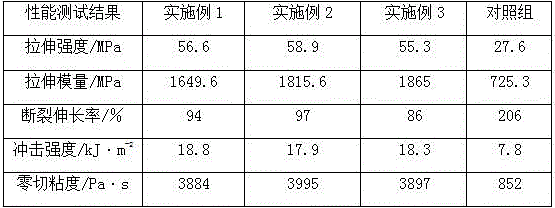Polymer material used for 3D printing and preparation method thereof
A high molecular polymer, 3D printing technology, applied in the field of 3D printing materials, can solve the problems of restricting the production of prototype polymer parts, modification of polymer parts, high manufacturing costs, etc., to achieve good toughness, good performance, high The effect of heat resistance
- Summary
- Abstract
- Description
- Claims
- Application Information
AI Technical Summary
Problems solved by technology
Method used
Image
Examples
Embodiment
[0015] The polymer material for 3D printing in this embodiment is composed of the following materials in parts by mass: 18 parts of polyurethane acrylate, 20 parts of epoxy resin, 16 parts of ethyl cellulose, 14 parts of polyethylene wax, silica fume 20 parts of stone powder, 16 parts of hydrogenated abietyl alcohol, 14 parts of epoxy acrylate, 20 parts of 2-hydroxy-4-methoxybenzophenone, 16 parts of trioctyl trimellitate, 14 parts of dipropylene glycol diacrylate , 20 parts of benzidine, 16 parts of polyoxyethylene laurate, 16 parts of nano-nickel oxide, 14 parts of polybutyl acrylate, 20 parts of trimellitic acid, 16 parts of isodecyl acrylate, 14 parts of barium stearate, 20 parts of calcium stearate.
[0016] Above-mentioned polymer material for 3D printing, its preparation method, comprises the following steps:
[0017] 1) After mixing the above-mentioned materials in parts by mass, add them into a twin-screw extruder, blend them evenly, and then extrude and pelletize to...
Embodiment 2
[0020] The polymer material for 3D printing in this embodiment is composed of the following materials in parts by mass: 20 parts of polyurethane acrylate, 22 parts of epoxy resin, 18 parts of ethyl cellulose, 16 parts of polyethylene wax, silica fume 22 parts of stone powder, 18 parts of hydrogenated abietyl alcohol, 16 parts of epoxy acrylate, 22 parts of 2-hydroxy-4-methoxybenzophenone, 18 parts of trioctyl trimellitate, 16 parts of dipropylene glycol diacrylate , 22 parts of benzidine, 18 parts of polyoxyethylene laurate, 18 parts of nano-nickel oxide, 16 parts of polybutyl acrylate, 22 parts of trimesic acid, 18 parts of isodecyl acrylate, 16 parts of barium stearate, 22 parts of calcium stearate.
[0021] Above-mentioned polymer material for 3D printing, its preparation method, comprises the following steps:
[0022] 1) After mixing the above-mentioned materials in parts by mass, add them into a twin-screw extruder, blend them evenly, and then extrude and pelletize to ob...
Embodiment 3
[0025] The polymer material for 3D printing in this embodiment is composed of the following materials in parts by mass: 22 parts of polyurethane acrylate, 24 parts of epoxy resin, 20 parts of ethyl cellulose, 18 parts of polyethylene wax, silica fume 24 parts of stone powder, 20 parts of hydrogenated abietyl alcohol, 18 parts of epoxy acrylate, 24 parts of 2-hydroxy-4-methoxybenzophenone, 20 parts of trioctyl trimellitate, 18 parts of dipropylene glycol diacrylate , 24 parts of benzidine, 20 parts of polyoxyethylene laurate, 20 parts of nano-nickel oxide, 18 parts of polybutyl acrylate, 24 parts of trimesic acid, 20 parts of isodecyl acrylate, 18 parts of barium stearate, 24 parts of calcium stearate.
[0026] Above-mentioned polymer material for 3D printing, its preparation method, comprises the following steps:
[0027] 1) After mixing the above-mentioned materials in parts by mass, add them into a twin-screw extruder, blend them evenly, and then extrude and pelletize to ob...
PUM
 Login to View More
Login to View More Abstract
Description
Claims
Application Information
 Login to View More
Login to View More - Generate Ideas
- Intellectual Property
- Life Sciences
- Materials
- Tech Scout
- Unparalleled Data Quality
- Higher Quality Content
- 60% Fewer Hallucinations
Browse by: Latest US Patents, China's latest patents, Technical Efficacy Thesaurus, Application Domain, Technology Topic, Popular Technical Reports.
© 2025 PatSnap. All rights reserved.Legal|Privacy policy|Modern Slavery Act Transparency Statement|Sitemap|About US| Contact US: help@patsnap.com

